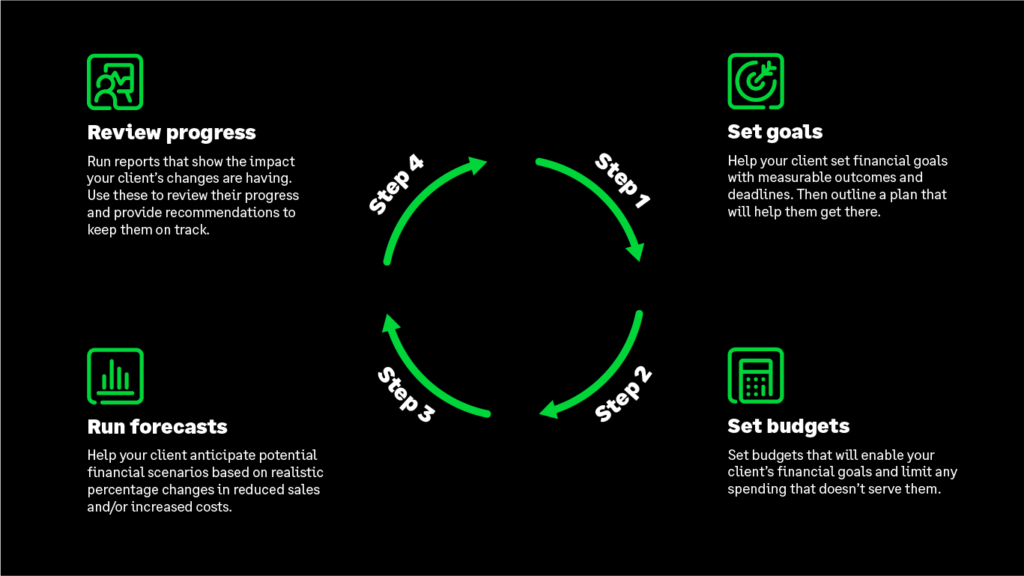Accountants
How accountants can guide and support their clients right now
Learn why helping your clients to change the way they think can give them a great chance to ensure their businesses thrive.

Businesses in every industry are feeling a squeeze on their cash flow.
Prices of everything from energy to materials are going up, while consumers are spending less.
For many, this brings more pressure to make sound financial decisions that ensures their businesses survive.
As an accountant, you can support and empower your clients to succeed through these tough times. Your knowledge of their finances and ability to extract insights from their information puts you in a unique position.
You can make a significant difference simply by helping clients to change the way they think.
In this article, we explore exactly how you should be guiding your clients during financial uncertainty.
It covers the following:
- The real reason your clients are struggling
- 5 profit-building tactics you can share
- How to hold your clients to account
- Why clients need more value from you now
- Final thoughts
The real reason your clients are struggling
Keeping a business financially healthy is difficult at the best of times.
But at the moment, business owners face pressure from every angle: operating costs are up, supply chains are disrupted, employees are nervous, and consumers are spending less.
You might have spoken to clients who are really struggling, feel unsure of what to do, and are looking for areas of their business to cut spend.
But an uncomfortable truth has to be said:
Navigating hard times is part of being in business.
From political uncertainty and recessions to the pandemic, businesses have had to weather storms in the past, and this one is no different.
The real reason your clients are struggling is because they haven’t built enough of a profit margin into their business to absorb steep fluctuations in costs and sales.
Being prepared for such spikes and dips over the long term is what ensures businesses survive and is often why smaller businesses tend to struggle more than the giants.
So, as an invaluable partner and adviser to their business, your priority should be to help your clients grow their profit margin.
And there are plenty of ways to do this.

5 profit-building tactics you can share
To help your clients stay financially strong, the first thing you need to do is change the way they think.
It can be incredibly easy for them to focus negatively on the challenges they face. Instead, adversity is a time for positive action, and you need to be the voice that empowers them build a higher profit margin.
Here are five tactics you can share with clients to do exactly that:
1. Review and expand product offering
Some businesses that enjoy a solid reoccurring customer base tend to keep their product or service offering largely unchanged.
But since customer spending habits are shifting, they need to evolve their offering to give people a reason to keep coming back.
Now is the perfect time to introduce additional products and services that complement the main offering.
It’s also worth the client reviewing the profitability of each of their products and services, so they can double down on those that are benefiting the business and reduce those that are not.
Check out this example…
A barber shop might consider introducing wet shaves, stocking new hair styling products, or selling hot and cold drinks for waiting customers.
If skin fades are the most popular or profitable style enjoyed by customers, they could run a promotional offer on this haircut to boost sales.
2. Increase prices
Advising your clients to raise prices can be a sensitive subject.
After all, it’s true that a large proportion of people currently have less expendable income, so it may feel risky to suddenly be charging more than what they’re used to paying.
However, even in these conditions, there are still people that do have expendable income. If you pay attention, you’ll notice people are still eating out, going shopping, and taking holidays.
With this in mind, you can position raising prices as a shift in which customers the business is targeting.
Yes, some existing customers that can’t afford the increase may be lost, but with the right approach and by increasing the value the business provides, new customers will be gained.
3. Train staff
A change in mindset doesn’t only apply to the business owner. Any new offerings or behaviours that are introduced will mean employees need to be brought up to speed.
Businesses should communicate clearly and be transparent on why decisions are being made. Then they need to train staff to be able to deliver the new products or services, or to explain changes (such as price increases) to customers where needed.
This is a great opportunity to improve employee retention by investing in their development.
From teaching staff how to upsell additional services, to helping them acquire new skills, owners can show their people that they are valued, while making the business more profitable.
4. Encourage regular payments
Repeat business can be a key factor in profitability.
For businesses that have a more passive approach to getting this, there are plenty of ways to become more proactive.
Some are subtle but effective, such as booking customers in for their next visit ahead of time. Others are more overt, such as offering and incentivising new subscription-based payment models.
Check out this example…
A pet care business could offer to book customers’ pets in for their next holiday as part of their checkout process.
For regular customers who book their pets in for day care during office hours, the business could switch to a subscription model at a slightly reduced overall rate.
5. Get financial support
Since you’re likely already providing guidance around compliance, it’s a good idea to help clients claim all the government financial support they’re entitled to.
Stay up to speed as new support packages are introduced and make sure clients aware of them.
From one-off grants to long-term schemes, even small amounts of money can go towards protecting a business’ cash flow.
Sometimes, a lack of understanding around whether a business qualifies or how much they’re able to get can be the only reasons support goes unclaimed.
Start by making them aware of any programmes that are already in place, such as the Energy Bill Relief Scheme.
How to hold your clients to account
Advising your clients to try some of the tactics above will inspire them to tackle uncertainty head on.
But you can go beyond providing them with ideas by holding them accountable for whatever actions they aim to take.
To do this, hold regular meetings that set measurable financial objectives and continually review their progress. You can build this around some of the tactics mentioned above or using any other goals the client is looking to achieve.
You can think of this accountability process as a four-step cycle:

Run this cycle on a regular basis, with frequent adjustments to goal setting, budgeting and forecasting.
This will keep your clients agile, so they can respond to market shifts and ensure their financial decision making is guided by whatever it is they hope to achieve.
Why clients need more value from you now
A lot of the guidance we’ve shared here is relevant to your accountancy practice too. This includes how much your clients spend with you, and you may notice some of them are looking to reduce this.
James Ashford, vice president of GoProposal by Sage, is already seeing this start to happen, and advises accountants to challenge clients that want to cut their spend:
He says: “The reason you need to keep your clients honest about rising costs is because the next place they’ll go to is to ask you to reduce your fee.
“You have to be prepared to challenge them, and not allow them to use this as an excuse.
“Show them that you’re the one who can help them build that margin, because it’s not just the current crisis – there will be other events in the future as well.”
Though the motivation to cut costs is understandable, now is actually the worst possible time for your clients to reduce their investment in the financial function of their business.
Periods of uncertainty are exactly when businesses need more advice, guidance, and expertise from their accountant.
If they work with you less, it’s likely that they’ll make decisions based on gut feeling, rather than dependable insights, solid financial planning, and hard data. That won’t set them up for survival or success.
When discussing spend with your clients, be sure to make it clear the value that you’re delivering. Keeping them accountable is a key aspect to focus on.
And if this goes beyond what you typically provide them with, make sure they’re aware of this and charge them appropriately.
Don’t shy away from expanding the services you are providing and adjusting billing to reflect that. Remind clients that their success is your success, and that you have an interest in helping them to maintain the financial health of their business.
As James points out: “To start retracting and retreating your service at times like these is not to be fair to your clients.”
Final thoughts
Despite the genuine difficulty that businesses are facing, it’s important to shift your clients away from thinking negatively.
Help them take positive action by providing them with sound financial planning and continuous guidance, while holding them accountable for progressing toward their goals.
By grounding goal setting around tactics that will help them grow a larger profit margin, you’ll help them build the capacity to absorb price rises from suppliers and reduced sales from customers.
Be transparent on the additional value you are providing your clients, and charge appropriately for the comprehensive support you are uniquely positioned to offer them.
Editor’s note: This article was first published in December 2022 and has been updated for relevance.






Ask the author a question or share your advice